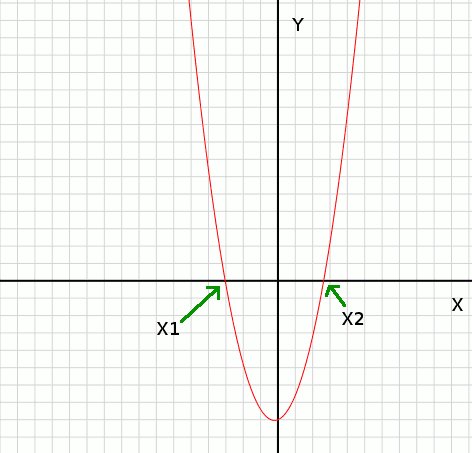![[hp15c]](hp15c-mini.gif)
HP15c program: quadratic equation solver, x2+p*x+q=0
This program uses only the stack (no storage registers) and it works for complex numbers.
command display
f LBL C 001-42,21,13
x><y 002- 34
2 003- 2
CHS 004- 16
÷ 005- 10
Enter 006- 36
* 007- 20
g LST X 008-43 36
g LST X 009-43 36
R_arrow_down 010- 33
R_arrow_down 011- 33
x><y 012- 34
- 013- 30
square root 014- 11
R_arrow_down 015- 33
g LST X 016-43 36
square root 017- 11
- 018- 30
x><y 019- 34
g LST X 020-43 36
+ 021- 40
g RTN 022- 43 32
This program uses the following label: LBL C
Using the program
I start every program with a label. This way you can have a number
of programs in your 15c and you just select which one to run by pressing f LABELNAME (f C in this case) or GSB LABELNAME (GSB C in this case).
This program finds the points x1 and x2 on the X-axis where the graph y=x2+p*x+q
intersects with the X-axis.

graph: y=x2+p*x+q
Quadratic equation: x2 + 0.5*x - 3=0
Roots: x2= 1.5 and x1= -2
The number in front of the x of the equation (called p further up) goes into y register of the stack and q goes into the x register of the stack (the x register is equal to the display line).
You type: 0.5, ENTER, 3, CHS, GSB C
The display shows "running" and then you see 1.5. This is one solution and you see the other one by pressing the "x><y" (swap x and y stack registers): x2=1.5 x1=-2
Here is a test equation for complex numbers: x2 -5i*x -6 = 0
Roots: x2= 3i and x1= 2i
You enter the complex numbers 0-5i and -6+0i as follows: 0, ENTER, 5, CHS, f I, 6, CHS, run the program with: GSB C
As solutions you should get 0 + 3i and 0 + 2i. So after running the program you will just see zero in the display. To see the full complex number you type and hold f (i). This shows the imaginary part as long as you hold the button. Release the button and type "x><y" (swap x and y stack registers) to see the second solution. It's also zero but the imaginary part is 2 (see with f (i) ).
Here is another a test equation for complex numbers: x2 -16*x +89 = 0
Roots: x2= 8 + 5i and x1= 8 - 5i
This equation has no solution in normal mode. You will get Error 0 if you are not in complex mode. But if you activate complex mode with "g SF, 8" (display shows a "c" on the right side of the display) then you will get the solutions: 8 + 5i and 8 - 5i.
It is possible that the quadratic equation has no solution (if you move the parabola above the X-axis such that there is no intersection with the X-axis). In this case you will see "Error 0" in the display.
Algorithm for solving and factorizing a quadratic equation
x2 + p*x + q=0 has the following 2 solutions:
x1=-p/2 - sqrt((p/2)2 - q)
x2=-p/2 + sqrt((p/2)2 - q)
The quadratic equation can also be written in its factored from
with x1 and x2 as shown above:
x2 + p*x + q = (x - x1)*(x - x2)
Note that the HP15c has as well the f SOLVE function
but this program is useful if you have to solve quadratic equations frequently.
Javascript quadratic equation solver
Quadratic equation:
x2 + p*x + q=0
or
in the factorized form:
x2 + p*x + q = (x - x1)*(x - x2) = 0
where
p=-(x1 + x2)
and
q=x1 * x2
Please enter p and q (note a limitation of this javascript code is that p and q can not be complex numbers):
© Guido Socher
![[hp15c]](hp15c-mini.gif)
